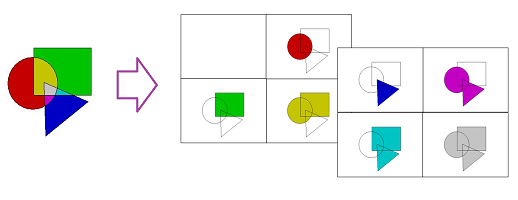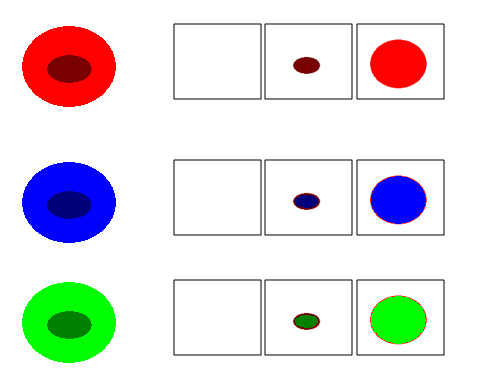This site is devoted to mathematics and its applications. Created and run by Peter Saveliev.
The topology of a color image
From Intelligent Perception
Contents
1 RGB color model
RGB stands for Red, Green, and Blue. These are the "channels" in a color image. The color effect is achieved by combining different levels of red, green, and blue. Each pixel has 3 numbers between 0 and 255 assigned to it.
Examples:
- $(255,0,0)$ red,
- $(0,255,0)$ blue,
- $(0,0,255)$ green,
- $(255,255,0)$ yellow,
- $(255,0,255)$ magenta,
- $(0,255,255)$ cyan,
- $(g,g,g)$ gray, for any $g$,
- $(0,0,0)$ black,
- $(255,255,255)$ white.
Every color image has three color channels - red, green and blue - and the image features you are after may be more pronounced with respect to one of them.
One can think of a color image as a 3-vector attached to each pixel or as 3 tables of integers, etc. Our approach to image analysis will be different. By means of a procedure similar to thresholding we represent color images as arrays of binary images. The color space is a 255×255×255 array with each entry corresponding to a particular color. As a result, thresholding a color image will produce a 255×255×255 array of binary images.
There are $8$ frames of the color image. They are binary images colored for convenience as a reference to the corresponding color:
We argue here that this image has only one object.
The goal is to detect and capture objects in an images. But what is an object? The answer is quite obvious in the case of a binary image. It is either a connected cluster of black pixels on white background or a connected cluster of white pixels on black background. What about a gray scale image? Our approach follows human perception - a dark region on a light background may be an object and so is a light region on a darker background.
This approach is also valid for color images; for example, one may have a dark red object on a light red background. A green object on a red background has no red and, therefore, is also detectable with this approach.
If only one of the three primary color is changing, the topology is the same as that of the corresponding gray scale image:
Similarly, all three colors may be changing producing the same effect of a dark object on a light background.
Summary: One shouldn't treat a color image as if it's a combination of three gray scale images. But it is a combination of binary images. These images are constructed via thresholding.
2 What is the topology of a color image?
The RGB color space is $$C = \{ (r, g, b) : 0 ≤ r, g, b ≤ 255 \}.$$ There is a natural partial order on $C$: $$r ≤ r’, g ≤ g’, b ≤ b’ \Rightarrow (r, g, b) ≤ (r’, g’, b’).$$
If only one of the three primary color is changing, the topology is the same as that of the corresponding gray scale image:
Then we recognize objects as darker areas surrounded by lighter background. Similarly, all three colors may be changing producing the same effect of a dark object on a light background. The rule applies to more general situations.
To make this specific, suppose we have a color image as a function $J:[0,N] \times [0,M] → C$, where $C$ is the RGB color space.
If we have any function $P:C → [0,255]$, then the composition $PJ:[0,N] \times [0,M] → [0,255]$ is a gray scale image. Suppose also that $P$ is increasing with respect to the partial order: $$r≤r', g≤g', b≤b' \Rightarrow P(r,g,b)≤P(r',g',b').$$ What this means is that the darker/lighter relationship between pixels is preserved under $P$ but some of it may disappear. In other words, the gray scale of $PJ$ is becoming darker as the color of $J$ is becoming darker.
Two things follow:
- Every darker area surrounded by a lighter background in the gray scale image $PJ$ appears as a darker area surrounded by a lighter background in the original image $J$, for any $P$.
- Every darker area surrounded by a lighter background in image $J$ appears as a darker area surrounded by a lighter background in the gray scale image $PJ$, for some $P$.
Therefore, in order to capture the topology of $J$ one needs to capture the topologies of all possible gray scale images $PJ$, without double counting.
A similar analysis will lead to an even simpler conclusion that in order to capture the topology of $J$ one needs to captures the topologies of all of its possible binarizations (via thresholding), without double counting.
3 Topology graph of a color image
The nodes of the topology graph are the objects and holes in the thresholded image and there is an arrow from node $A$ to node $B$ if:
- object $B$ has hole $A$, provided $A$ and $B$ correspond to consecutive colors.
- object $B$ has hole $A$, provided $A$ and $B$ correspond to the same color.
- And vice versa.
Each of these slices is the topology graph of the gray scale image obtained from the color image by fixing a value of, say, green and blue and letting red vary. The end result is a box filled with graphs connected with its neighbors.
4 Analysis algorithm
All pixels in the image are ordered according to the partial order.
- Following this order, each pixel is processed:
- add its vertices, unless those are already present as parts of other pixels;
- add its edges, unless those are already present as parts of other pixels;
- add the face of the pixel.
- At every step, the graph is given a new node and arrows that connect the nodes in order to represent the merging and the splitting of the cycles:
- adding a new vertex creates a new component;
- adding a new edge may connect two components, or create, or split a hole;
- adding the face to the hole eliminates the hole.
Further:
- Same as for gray scale but based on the partial order above
- Threshold the image to create $256 \times 256 \times 256$ binary images.
- Collect all objects and holes in the topology graph, as above.
- Filter noise out if necessary.
- Choose the tips, etc to give the "binary" topology of the image.
Digital discoveries
- Casinos Not On Gamstop
- Non Gamstop Casinos
- Casino Not On Gamstop
- Casino Not On Gamstop
- Non Gamstop Casinos UK
- Casino Sites Not On Gamstop
- Siti Non Aams
- Casino Online Non Aams
- Non Gamstop Casinos UK
- UK Casino Not On Gamstop
- Non Gamstop Casino UK
- UK Casinos Not On Gamstop
- UK Casino Not On Gamstop
- Non Gamstop Casino UK
- Non Gamstop Casinos
- Non Gamstop Casino Sites UK
- Best Non Gamstop Casinos
- Casino Sites Not On Gamstop
- Casino En Ligne Fiable
- UK Online Casinos Not On Gamstop
- Online Betting Sites UK
- Meilleur Site Casino En Ligne
- Migliori Casino Non Aams
- Best Non Gamstop Casino
- Crypto Casinos
- Meilleur Site Casino En Ligne Belgique
- Bookmaker Non Aams
- онлайн казино с хорошей отдачей
- スマホ カジノ 稼ぐ
- Trang Web Cá độ Bóng đá Của Việt Nam


